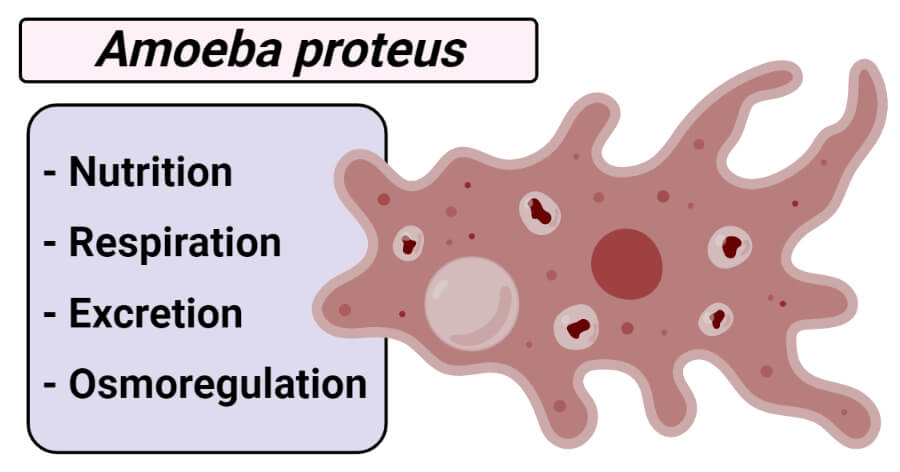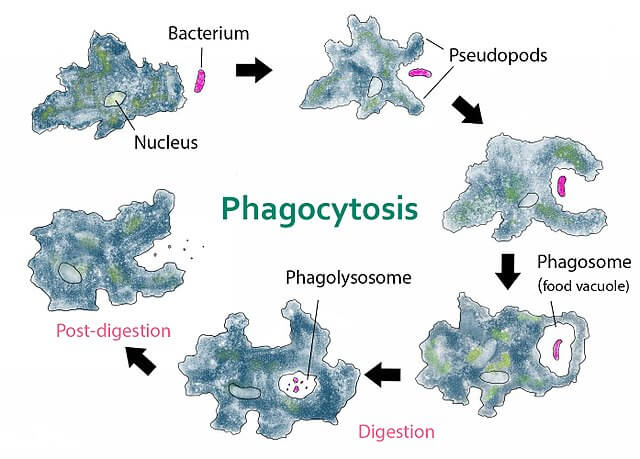
Interesting Science Videos
Nutrition of Amoeba proteus
Food and selection of food
- Amoeba is carnivorous.
- It feeds by phagocytosis.
- The mode of nutrition is Zootrophic or holozoic. i.e. it requires ready-made (solid form) organic substances for food.
- The food consists of algal cells and filaments, bacteria, desmids, flagellates, ciliates, small metazoans such as rotifers and nematodes, and organic matter.
- Amoeba is able to select its food even in absence of special sense organs.
- It is also able to discriminate organic food particles from an organic sand particle.
- It will ingest the food and leave the carbon dioxide out if the particle of carbon is fixed to the food.
- Nutrition involves a number of processes i.e. ingestion, digestion, absorption, assimilation, dissimilation, and egestion.
- It does not have any specialized organs for nutrition. The process of ingestion is carried through the body surface with the help of pseudopodia.
1. Ingestion
- Ingestion is the process of taking the food into the body either by swallowing or absorbing it.
- There is no mouth or definite organelles for food intake.
- Amoeba captures or engulfs the prey (food) forming food vacuole by pushing out pseudopodia. This process is known as phagocytosis.
- According to Rhumbler (1930), Amoeba takes its food in 4 possible ways depending upon the nature of the food.
a. Import: in this method food such as algal filament on contact passively sinks into the body by rupturing the plasmalemma and ectoplasm at the point of contact. The rupture site soon heals up.
b. Circumvallation: In this method, Amoeba sends out the pseudopodia around the prey forming a cup-like structure called a food cap. The food cup does not touch the food, but edges of the food cup fuse around the food to form a non-contractile food vacuole with a considerable amount of water. This method of ingestion is used for capturing active prey like flagellate or ciliate.
c. Circumfluence: In this method, when Amoeba comes in contact with less active or immobile bacteria, a pseudopodium comes in contact with bacteria and envelope it completely in a food vacuole within the cytoplasm. By repeating this process, the Amoeba can also ingest and roll up long filaments of algae. In other species of Amoeba, food is ingested by import and invagination.
d. Invagination: In this method, food is adhered to by toxic and sticky secretion of the ectoplasm. The ectoplasm along with food is enfolded as a tube into the endoplasm, and the food particle is sucked in, the plasmalemma disappears and ectoplasm changes into endoplasm.
In a large primary food vacuole, the newly ingested organism may remain active. Within an hour, the primary food vacuoles break down into smaller secondary vacuoles, these subdivide into numerous minute vacuoles which form a large portion of the endoplasmic content.
e. Pinocytosis: It is the ingestion of liquid food in bulk. It takes place by the cell through the plasma membrane. It is induced by proteins, inorganic ions, and certain dyes. It does not take place through the whole surface of the body of the amoeba. It is thought that plasma lemma bound with the colloidal food material forms pinocytosis channels which run from the surface deep into the endoplasm. From the internal ends of these channels, pinocytosis vesicles or pinosomes, containing engulfed liquid material. The pinosomes are transported to cells where they then fused with a lysosome. It is not yet been confirmed whether pinocytosis is a normal means of ingestion in Amoeba.

Figure: Phagocytosis in Amoeba. Image Source: Wikimedia.
2. Digestion
- It takes place in the primary food vacuole.
- Food vacuole or gastric vacuole is formed by the extension and joining of the pseudopodia that capture the prey.
- Small and large such vacuoles are seen in actively feeding Amoeba.
- Lysosome containing digestive enzymes fuse with the food vacuole and the digestion of food slowly continues.
- The reaction in food vacuole is acidic at first and later become alkaline.
- In the acidic medium, the food organism is killed.
- In an alkaline medium, digestion of starch, proteins, and fat takes place with the help of enzymes amylase, protease, and lipase respectively.
- When the food is reduced to molecular form, the food vacuole bud off smaller and smaller secondary food vacuole which carry the digested food.
- The digestion is intracellular in Amoeba.
3. Absorption
- In this process, the nutrients from the digested food material, water, and minerals are absorbed into the protoplasm by simple diffusion by leaving behind the undigested particles.
- The excess food is stored in the form of glycogen and lipids.
- The food vacuoles move continuously in the streaming movements in the endoplasm known as cyclosis which directly supplies nutrition to all the parts of the cell.
- The digested food diffuses out into the cytoplasm.
- It takes about 30 hours for the completion of digestion.
4. Assimilation and dissimilation
- The digested food is then assimilated to form new protoplasm.
- For the formation of living protoplasm, amino acids are manufactured; sugar, fatty acids, and glycerol provide energy.
- Heat, dynamic energy, and waste products are formed by the breakdown of living protoplasm by the process of oxidation.
- For the various activities of the Amoeba, the complex particles of protoplasm are broken down by the process of dissimilation.
5. Egestion
- It is the process of elimination of undigested food material.
- Removal of the undigested food material takes place at any point on the surface of the body.
- There is not any definite exist for this purpose.
- In actively moving Amoeba, the undigested residue of food vacuole is shifted backward and discharged at the posterior end, as the animal moves on.
Respiration in Amoeba proteus
- Respiration is the process of interchange of oxygen coming inwards and carbon dioxide going outwards.
- Amoeba has no special respiratory organs.
- It has no respiratory pigments.
- Respiration occurs in it by the process of diffusion through the general body surface (plasmalemma) which is permeable to the oxygen gases dissolved in the surrounding water.
- The oxygen gas diffused inside the body is used up by Amoeba.
- In the body, the absorbed oxygen gases bring about the enzymatic breakdown (oxidation) the complex food material like carbohydrates, fats, and even proteins into simple compounds.
- The energy which is produced during the oxidation reaction is stored in the high energy bonds of ATP and used for the life activities of the organism.
- Metabolic wastes like carbon dioxide and water are formed by the oxidation of carbohydrates and fats.
- The carbon dioxide gas is diffusing in the surrounding water as well as in water discharged by the contractile vacuole by the same process of diffusion.
Excretion in Amoeba proteus
- In the body of Amoeba, carbon dioxides are produced by the metabolism of fats and carbohydrates, whereas ammonia are produced by the metabolism of protein.
- Amoeba is an ammonotelic animal because it excretes nitrogenous wastes in the form of ammonia.
- It has no special excretory organs.
- These waste materials are excreted out by diffusion from the general body surface in surrounding waters.
- Contractile vacuoles also play some role in the removal of waste materials. The waste materials present in the cytoplasm arrive in the contractile vacuole which comes in close contact with the plasma membrane and ruptures out to release its content in the surrounding.
Osmoregulation in Amoeba proteus
- It is the process of internal balance between water and dissolves materials irrespective of environmental conditions.
- The protoplasm of A. proteus is of higher concentration than the freshwater of its environment which causes the water to enter into the body by endosmosis through the semi-permeable plasmalemma.
- Some waters are formed by metabolic activities and some are taken along with ingested food organisms. So, to prevent the swelling and ruptures of the animal due to excess water, the contractile vacuole collects the excess water which is less dense than the surrounding cytoplasm and are expelled out of the protoplasm.
- This contractile vacuole disappears and a new one starts to form in the endoplasm.
- When placed in freshwater marine Amoeba develops the contractile vacuole.
- When the freshwater Amoeba is placed into the saltwater their contractile vacuole decreases and disappears.
- The main function of the contractile vacuole is osmoregulation, even though carbon dioxide and nitrogenous wastes are also excreted through it.
Reference and Sources
- Kotpal RL. 2017. Modern Text Book of Zoology- Invertebrates. 11th Edition. Rastogi Publications.
- Jordan EL and Verma PS. 2018. Invertebrate Zoology. 14th Edition. S Chand Publishing.
- 9% – https://www.biologydiscussion.com/invertebrate-zoology/protozoa/amoeba-proteus-habitat-structure-and-metabolism/28183
- 5% – https://onlyzoology.com/full-nutrition-in-amoeba-how-does-amoeba-obtain-its-food/
- 4% – https://www.qsstudy.com/biology/nutrition-process-of-amoeba
- 1% – https://www.toppr.com/ask/question/passive-food-ingestion-in-amoeba-is-known-as/
- 1% – https://www.studyandscore.com/studymaterial-detail/paramecium-respiration-excretion-osmoregulation-and-response-to-stimuli
- 1% – https://www.qsstudy.com/biology/respiration-process-of-amoeba
- 1% – https://byjus.com/biology/amoeba/
- <1% – https://www.qsstudy.com/biology/what-is-amoeba
- <1% – https://sciencing.com/reduced-oxidized-photosynthesis-6469086.html
- <1% – https://quizlet.com/43906511/digestion-flash-cards/
- <1% – https://quizlet.com/11204394/ingestion-flash-cards/
- <1% – https://healthyeating.sfgate.com/functions-amylase-protease-lipase-digestive-enzymes-3325.html
- <1% – https://courses.lumenlearning.com/boundless-biology/chapter/digestive-system-processes/
- <1% – https://courses.lumenlearning.com/biology2xmaster/chapter/nitrogenous-wastes/
